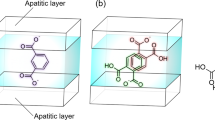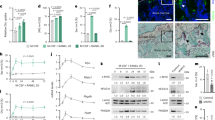Abstract
HEATING of bone to 325° C has been shown to induce the formation of pyrophosphate1–3. The quantity of pyrophosphate so formed is greater in the epiphysis than in the diaphysis and greater in the younger than in the older animal, and is therefore presumably greater in newly laid down than in older bone salt1. The question to be investigated is whether pyrophosphate-yielding mineral of new bone has specific chemical characteristics. There is much evidence which suggests that the tetracyclines are deposited in high concentrations in newly formed bone salt4. This communication demonstrates that the tetracycline labels the form of the bone salt that yields pyrophosphate in large amounts after heating.
This is a preview of subscription content, access via your institution
Access options
Subscribe to this journal
Receive 51 print issues and online access
$199.00 per year
only $3.90 per issue
Buy this article
- Purchase on SpringerLink
- Instant access to full article PDF
Prices may be subject to local taxes which are calculated during checkout
Similar content being viewed by others
References
François, P., J. Physiol. (Paris), 53, 343 (1961).
François, P., and Herman, H., Bull. Soc. Chim. Biol., 43, 643 (1961).
Herman, H., and Dallemagne, M. J., Arch. Oral Biol., 45, 137 (1961).
Urist, M. R., and Ibsen, K. H., Arch. Path., 76, 484 (1963).
François, C., Bull. Soc. Chim. Biol., 42, 259 (1960).
Fiske, C. H., and Subbarow, Y., J. Biol. Chem., 66, 375 (1925).
Author information
Authors and Affiliations
Rights and permissions
About this article
Cite this article
IBSEN, K., URIST, M. Relationship between Pyrophosphate Content and Oxytetracycline Labelling of Bone Salt. Nature 203, 761 (1964). https://doi.org/10.1038/203761a0
Published:
Issue date:
DOI: https://doi.org/10.1038/203761a0



